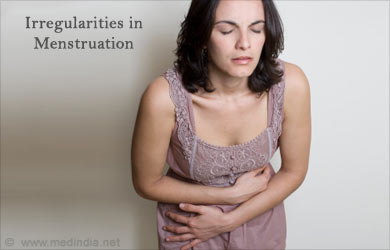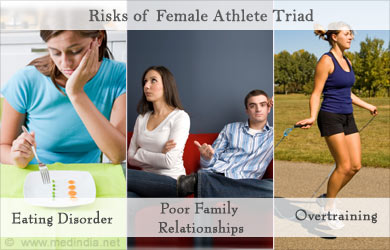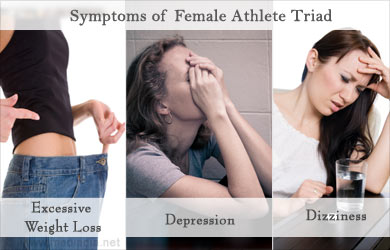- The Female Athlete Triad - (http://www.aafp.org/afp/2000/0601/p3357.html)
- Doyle-Lucas AF, Akers JD, Davy BM. Energetic efficiency, menstrual irregularity, and bone mineral density in elite professional female ballet dancers. J Dance Med Sci. 2010;14(4):146-154.
- De Souza MJ et al. Consensus statement: 2014 Female Athlete Triad Coalition Consensus Statement on Treatment and Return to Play of the Female Athlete Triad: 1st International Conference held in San Francisco, California, May 2012 and 2nd International Conference held in Indianapolis, Indiana, May 2013. Br J Sports Med. 2014;48:4 289 doi:10.1136/bjsports-2013-093218.
- Javed A et al. Female athlete triad and its components: toward improved screening and management. Mayo Clin Proc. 2013;88(9):996-1009.
- Female Athlete Triad - (http://kidshealth.org/teen/food_fitness/sports/triad.html)
What is Female Athlete Triad?
The competition in sports and the obsession to win medals has lead to an unhealthy condition among female athletes. In the desire to excel, a female athlete may wish to be lightweight and thin. In order to achieve this objective they may start eating too little and exercising to the extreme. In the long term this practice can lead damage their health and sometimes in an extreme case even lead to death. Similar problem has also been seen among young ballerinas and women in military training.
The term "female athlete triad" was coined by the American College of Sports Medicine in 1992 for such a condition and the definition was later updated in 2007. As the name suggests, three conditions affect these women -
- Disordered Eating Habits or Excessive exercise that deprives the body of adequate nutrition.
- Menstrual irregularity and sometimes menstruation stops (amenorrhea) due to hormonal changes occurring from low calorie intake, stress and low percentage of body fat.
- Low Bone Mineral density (BMD for age leads to premature osteoporosis due to lack of nutrition and minerals
All three conditions are interrelated and the three interrelated illnesses has been given the name 'Female Athlete Triad'

Factors for Female Athlete Triad
As explained above, we are aware of the 3 main components of female athlete triad, which are, abnormal menstruation, low energy that may or may not result from irregular eating habits, and finally the effect on BMD.
Energy Restriction
This is an important factor in the female athlete triad condition. Based on the kind of sporting activities and the requirements of the sports, female athletes may restrict the caloric intake (irregular eating) and in turn, reduce the energy produced. In lean sports (e.g., gymnastics, ballet), the requirement of certain body aesthetics causes female athletes to suffer from a greater risk of bulimia and anorexia.
Irregularities in Menstruation
Menstrual irregularities are common in physically active women. Approximately 12% to 79% of female athletes especially those in lean sports experience irregularities in menstruation. Some of the female athletes may suffer from amenorrhea, which is absence of menstruation. It has been observed that eating disorders play a large role in causing irregularities in menstruation.

Low BMD
It has been observed that female athletes generally have a higher BMD than non-athletic women. However, based on the type of sporting activities, the loss in BMD is variable. Activities like gymnastics result in a loss of BMD compared with swimming. Low energy and low estrogen levels affect BMD. The BMD in children and premenopausal women is indicated with a Z score; a low BMD has a Z score of less than-2.
Causes and Risks of Female Athlete Triad
The main cause of the female athlete triad condition is the kind of physical activities that women engage in. It has been observed that there is a high frequency of expression of the individual conditions, which are low energy, or irregular menstruation, or low BMD. However, the frequency of the 3 conditions occurring together is quite low. Any 2 conditions together are also considered as representative of the female athlete triad condition.
Lean Sports (e.g., gymnastics, ballet, figure skating)
Such activities lay a stress on body aesthetics to achieve perfection in the sport. It has been observed that the risk of individuals in these sporting activities to suffer from the female athlete triad condition is much higher (2 to 3 times) than for those in other types of sports.
Irregularities In Eating
Most sportswomen display irregularities in eating that, in turn, contribute to reduced energy availability. The amount of food consumed is either lower than the required levels or the level of food consumed does not match the energy utilized by the individual.
Hormonal Changes, Stress or A Deficit In Energy Levels
The menstrual irregularities in sportswomen may be due to hormonal changes, stress or a deficit in energy levels.
Causes of low BMD
The decrease in BMD is independently regulated by deficits in energy and by menstruation irregularities. It has been observed that sportswomen with regular periods but with low energy availability can still display a loss in BMD. Sportswomen who have deficits in energy levels and are amenorrheic, experience a higher risk of fractures.
Conditions that increase the risk of female athlete triad are:
- Girls beginning their sports training at a young age
- Prior history of menstrual irregularities, stress fractures or eating disorder
- Psychosocial pressures that are applied to achieve the perfect thin body figure
- Imposed dietary restrictions
- Poor family relationships
- Involvement in thin or aesthetic sports (e.g., figure skating, ballet)
- Overtraining

Symptoms of Female Athlete Triad
Some of the symptoms of female athlete triad are as follows:
- General dissatisfaction with the body; excessive preoccupation with food, weight, and mealtimes
- Personality traits, such as obsessiveness and perfectionism
- Secretive eating and avoiding team meals
- Excessive weight loss
- Increased dieting
- Enhanced exercise routine in addition to the regular exercise regimen
- Increased frequency of fractures (stress fractures) and illness. Stress fractures may be associated with:
- Delay in menarche
- Irregularity in menstruation
- Decreased bone mineral density
- Errors in training routine
- Dietary irregularities
- Foul breath and swollen parotid salivary glands due to vomiting that is self-induced
- Frequent mood swings
- Increased tendency for sore throat
- Inability to achieve the best performance while exercising
- Exhaustion and dizziness
- Reduced self-esteem with associated depression
- Yellow skin and soft hair on the skin
- Reduced body mass index (BMI)

Diagnosis of Female Athlete Triad
The condition of female athlete triad can be prevented by screening for the condition at an early stage. To detect female athlete triad at an early stage, sportswomen are required to fill out some screening forms. A common survey form is the PPE or the pre-participation physical evaluation, and it consists of 9 survey questions related to the condition. The PPE screening test has been approved by 6 medical societies in the USA. Similarly, the International Olympic Committee (IOC) – Periodic Health Survey consists of 8 questions addressed to girls and women in connection with the triad.
Diagnosis of Energy Availability
This involves analyzing the calorie intake and the expenditure of energy. A registered dietitian can assist in understanding the dietary deficiency that may cause irregularities in energy availability. An exercise physiologist can analyze the energy consumption of the individual.
Diagnosis of Menstruation Irregularities
Sportswomen, who experience irregularities in menstruation have to be analyzed for thyroid deficiency, pregnancy, pituitary and hypothalamic disorders, ovarian insufficiency, or for excess androgen production leading to polycystic ovaries, adrenal tumors, and other conditions. A pregnancy test, physical examination, medical history, thyroid function tests are some of the diagnostic tests to detect irregularities in menstruation. A pelvic examination and a 17-hydroxyandrosterone test are other tests to confirm the cause of menstrual irregularities. An endocrinologist along with a primary-care physician can confirm the cause of menstruation irregularities due to the endocrine system.
Diagnosis of Low BMD
Individuals with low BMD may be diagnosed with DXA (dual-energy x-ray absorptiometry) scan. The sites of DXA scans vary based on the age of the individual. For women less than 20 years of age, the whole body except the head is scanned along with the posteroanterior portion of the spine. In women older than 20 years, the hip and the posteroanterior portion of the spine are scanned.
Treatment for Female Athlete Triad
The treatment options for the female athlete triad condition, include pharmacological therapies, non-pharmacological therapies, hormone replacement therapy (HRT), psychological therapy, and prevention and management.
Pharmacological Therapies
Based on the causes and symptoms, female athlete triad can be treated with antidepressants. Women are also recommended to have calcium (1300 mg/d) and vitamin D (~1000 IU/d) in their diet to improve the daily consumption.

Nutritional Therapies
Individuals with the female athlete triad condition have eating disorders that affect their energy levels. Registered dietitians can work with sportswomen that display the female athlete triad condition. An appropriate meal plan may be recommended, and individuals must follow the meal plan in a disciplined manner to obtain the necessary energy levels.
Hormonal Replacement Therapy
This form of treatment is not usually recommended but is sometimes suggested when the nutritional uptake fails to improve BMD. Ethinyl estradiol is an oral contraceptive pill that is prescribed in such cases.
Exercise Regimen
Athletes should be encouraged to perform weight-training exercises to stimulate bone formation. A physical therapist may monitor and modify the exercise regimen based on the athlete’s needs and symptoms.
Tips for Female Athletes
All female athletes should follow the advice of the dietitian, physical therapist, and the physician once they are diagnosed with the female athlete triad condition. Failure to adhere to the recommendations may result in health complications and an inability to continue the sporting activity. The success of managing this condition is based on the participation and willingness to follow the screening, diagnosis, and treatment regimens for the female athlete triad condition.
Some of the ways by which female athletes can prevent health issues related to the female athlete triad condition are as follows:
Eat Regularly
Women should not miss their meals due to a hectic routine. Keep healthy snacks to munch at any time of the day.
Dietitian’s Advice
Follow the recommendations of an expert dietitian or nutritionist to manage the nutritional intake in the body and to meet the energy requirements.
Monitor Menstruation Cycle
Irregularities in menstruation is a major factor of the female athlete triad condition. Women can seek medical help when they notice these irregularities.
Follow Your Heart
Do not succumb to the pressure of family, peers, or coaches. If your body is suffering from excess exertion, it is better to quit the sport than ruin your health for the rest of your life.







